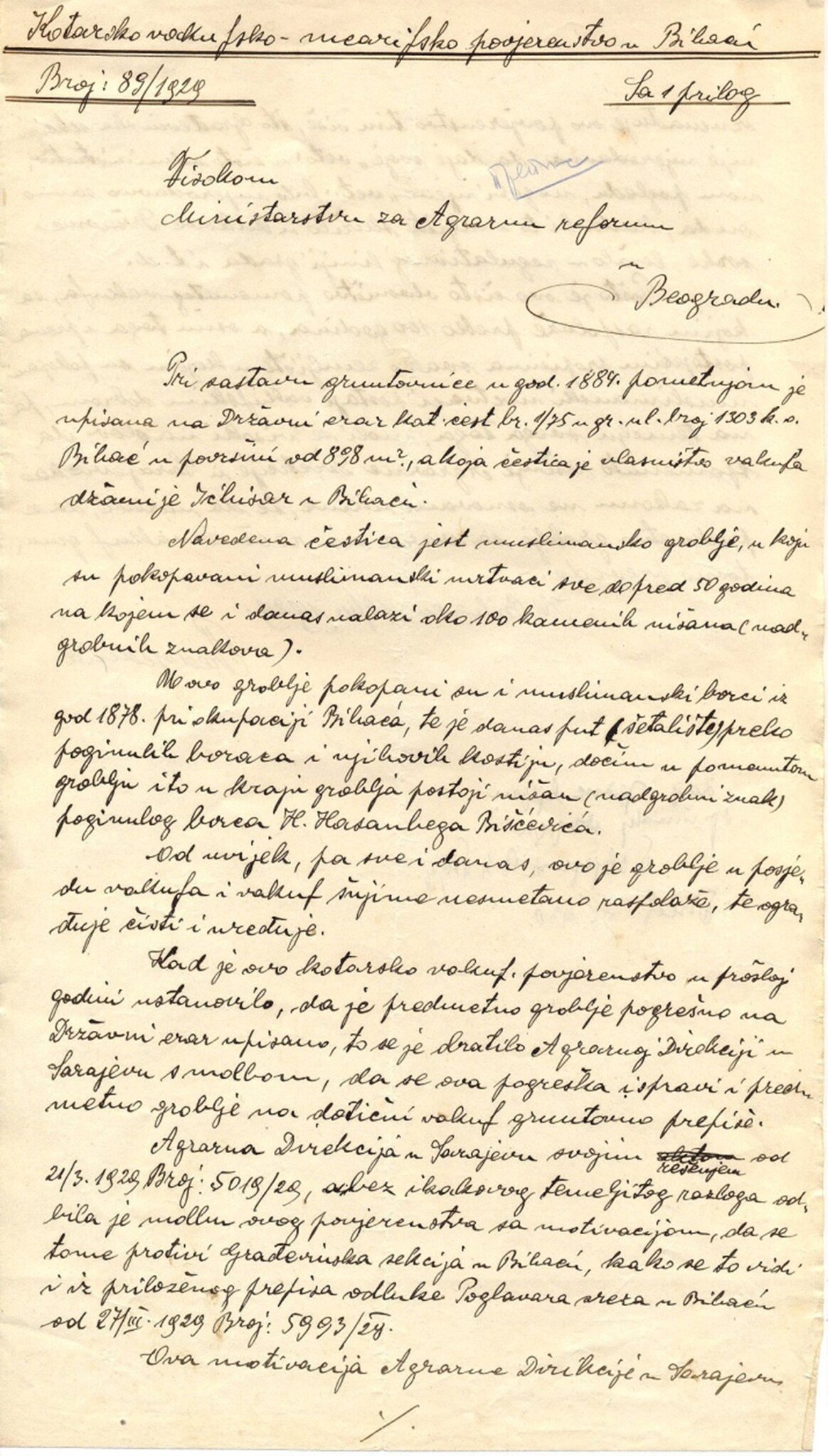
ŠEHITLUCI IN BIHAĆ
Author: Suad Mahmutović, MA, Madrasa “Reis Džemaludin-ef. Čaušević” in Cazin • Illustration: The letter of the District Administrative Committee in Bihać

It is well known that city cemeteries in Bosnia and Herzegovina have been turned into parks following explicit orders by Minister Benjamin Kalay in the early 20th century. It was the case in Bihać as well. One cemetery in Bihać was turned into a cattle market, and the cemetery next to the Ićhisar Mosque into a promenade. It is a lot which is found in the land registry under number 1303, lot number 1/75, of a total area of 898 m², cemetery of the Ićhisar Mosque in Bihać. When the Land Registry was being drawn up, in 1884, this lot was entered as the property of the state treasury although it had always been owned by the mosque waqf (Letter by the Main Administrative Committee).
The Committee in Bihać litigated the case of this lot for years. In 1931, even witnesses were subpoenaed: Osman Redžić, son of late Haso, 80 years old, and Ibro Delić-Sarić, son of late Meho, 60 years old, who testified before the City Council in Bihać that the land in question had always been owned by the waqf of the Ićhisar Mosque (Certificate of the City Council) The State Council of the Kingdom of Yugoslavia issued a ruling which revoked the order of the Ministry of Agriculture of 12 February 1930, which provided that this lot should serve to public interests or for the purpose of beautifying the city as a park. (Ruling of the State Council).
According to testimony by Salko Ibukić, 70 years old, which he gave before the District Waqf Committee in Bihać on 13 October 1932, this cemetery housed about 100 tombs with stone nišans (Islamic tombstones), and nobody had been buried at this cemetery from the occupation. The cemetery was enclosed by barbed wire and concrete pillars, which were funded by Mehmed-bey and his son Ali-beg Alajbegović (Minutes). The land was owned by the waqf of the Ićhisar Mosque for over a hundred years. Muslim fighters – shahids (martyrs) who were killed in 1878 during the occupation of Bosnia and Herzegovina by Austro-Hungary were buried there. The tombstone of the killed fighter h. Hasan-beg Bišćević was also at this cemetery. On this site, a promenade was made over the bones of these fighters (Letter of the District Administrative Committee in Bihać addressed to the Ministry for Agrarian Reform). In the Land Registry, this lot is now recorded as a cemetery, general state assets. It is a lot across the coffee shop “Paviljon”, i.e. part of the city park “Gelenderiˮ in the very center of Bihać. It would be moral, civilizational, even human to put a plaque with the inscription that there used to be Šehitluci (cemetery for fallen fighters – shahids) at this site.
A logical question arises: how many people have sat or walked over tombs of these shahids over the past almost fourteen decades, without even being aware of it?!
The letter of the District Administrative Committee in Bihać to the Ministry of Agrarian Reform in Belgrade
Tombstones of these, as well as other city tombs have been built into family houses, into the dam, the so-called “concrete”, now the famous bathing place in Bihać, as well as on the banks of the ditch, which could be seen during reparations of the concrete part of the bends of this canal. In this way we have destroyed the culture of remembrance of our champions of the late 19th century. Are we entitled to such an attitude for the sake of our own future?
References:
A letter of the Main Administrative Committee in Sarajevo addressed to the Regional Council in Bihać under the number: 2103 /30, 14 April 1930.
Certificate of the City Council of Bihać number: 2292/31 of 18 June 1931.
Ruling of the State Council of the Kingdom of Yugoslavia number: 36174/30 of 20 February 1930.
Minutes taken on: 13.10.1932 at the District Administrative Council in Bihać.
A letter of the District Administrative Council in Bihać addressed to the Ministry of Agrarian Reform in Belgrade, number: 89/1929 of 10.04.1929.

